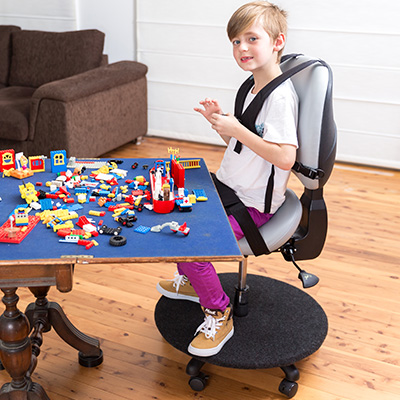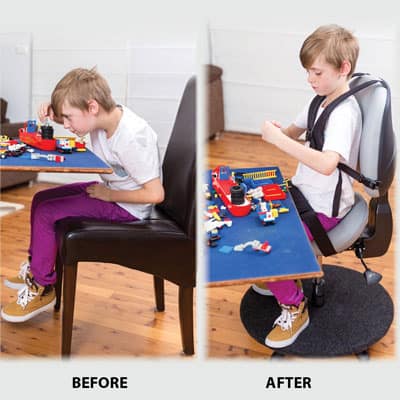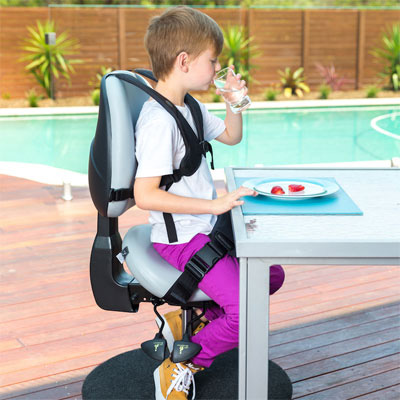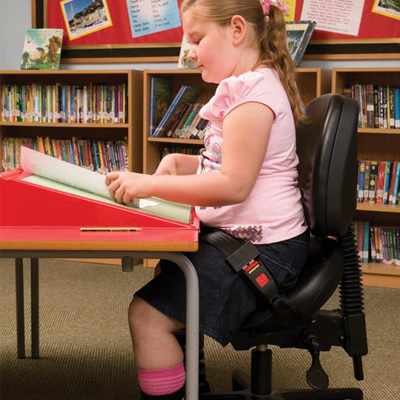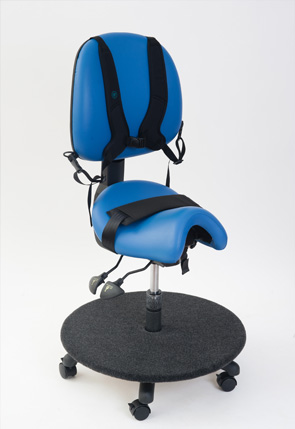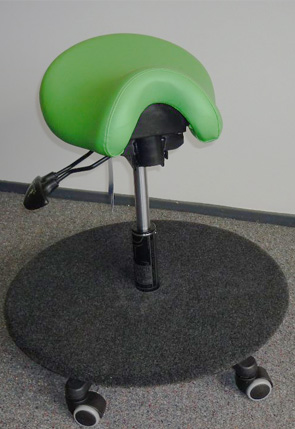Ergonomic Chairs For Special Needs
Bambach and the Special Needs environment
The Bambach Saddle Seat is used by health professionals and carers worldwide as a therapeutic seat to sustain and promote a healthier sitting posture. Case studies have also shown dramatic improvements for people with mild to severe disabilities who have used the Bambach, aged as young as two years old, through to those in their nineties. Use of the seat aids independence improves quality of life and helps to prevent future disabilities. These case studies can be downloaded using the links provided below.
How the Bambach can help people with disabilities:
Postural Control
- Activating the muscles of postural control so they can work in balance, rather than being inactive, as they are in conventional seating and wheelchairs.
- Providing secure pelvic control, maintaining an upright stable pelvis.
- Placing the hips in their optimal resting position of 45 degree flexion.
- Providing a posture where the trunk and head control is easier so that functional activity, such as speech and swallowing is improved.
- Allowing the forward bend from the hips, not the waist, retaining balance for reading and writing even when leaning forward. Case study 15
- Opening up and maintaining maximum space for the chest and abdomen so that breathing and digestion are easier. Case study 11
Functional Improvements
- Full plantar contact, encouraging muscle activity and partial weight bearing up to the standing from the half-sit position. As seen in case study 19, the ability to transfer from and to a wheelchair was made possible.
- Facilitating independent sitting, encouraging ease for upper limb and hand coordination. Case study 1 and case study 10
- Maintaining thoracic and abdominal space to improve concentration, breathing and lung function. Case study 11
- The position of your body with the centre of gravity over the sit bones provides a clear midline advantage which promotes balance and symmetry, and aids coordination and dexterity. Case study 16
- Promoting upright posture, the individual’s muscles are actively engaged (switched on) rather than in an inactive and collapsed state as on a conventional seat or in a wheelchair. Case Study 6
- Improving trunk and head control, speech and swallowing can improve.
- Maximising thoracic, abdominal and pelvic spaces in an open position has resulted in improved breathing, digestion and circulation in many cases. Case study 18
- Providing greater control of sensory output can help reduce involuntary motor responses. Case study 16
- Reducing fatigue associated with poor posture. Case study 13
Note: The functional benefits are not limited to the above and are growing with every new and varied disability case, improving quality of life for the individual, and their families and friends.
Positive Social/Psychological Impact
- Maintaining an upright posture, eye contact and social interaction is easier.
- Speech and swallowing are easier, so socialising is more natural.
- Self-esteem is improved due to enhanced functional ability and mobility. In case study 6, David Boyle said that he felt and looked more normal as he did not need his wheelchair.
- Writing, schoolwork, and hobby performance are enhanced due to increased efficiency and control of the upper body and arms in an upright stable position. Luke Frew who has CP reported “improved ability for computer work, writing, drawing and reading.” Case study 19
- Independent personal care and self-care like meal preparation, washing and dressing are made easier on a Bambach than in a wheelchair in many cases. This was evident in case study 1 (severe back injury), and case study 10 (amputee).
Growth In Children And Adolescents
- Due to the dynamic sitting position on the Bambach, muscle activity and movement is increased which stimulates normal bone growth.
- Due to the half-stand position on the Bambach, righting reactions and midline alignment maintains muscle length and joint range of movement.
How do I find out more about the Bambach?
Please email or phone to speak with one of our experienced staff members to discuss how the Bambach can be customised to suit individuals and help a wide range of special needs conditions. It is recommended that you contact your healthcare provider as you may be eligible for funding and a trial in your home, workplace or school.
Need more information?
Case Studies (scroll to find Special Needs case studies)
An Opinion On The Theory of Ergonomic Seating Verses The Facts by M Gale
Bambach Accessories (scroll to find Special Needs Accessories)
When seated on a Bambach, my patients’ posture improves remarkably, giving them the ability to perform daily tasks otherwise deemed impossible.
-Janelle, Occupational Therapist.


